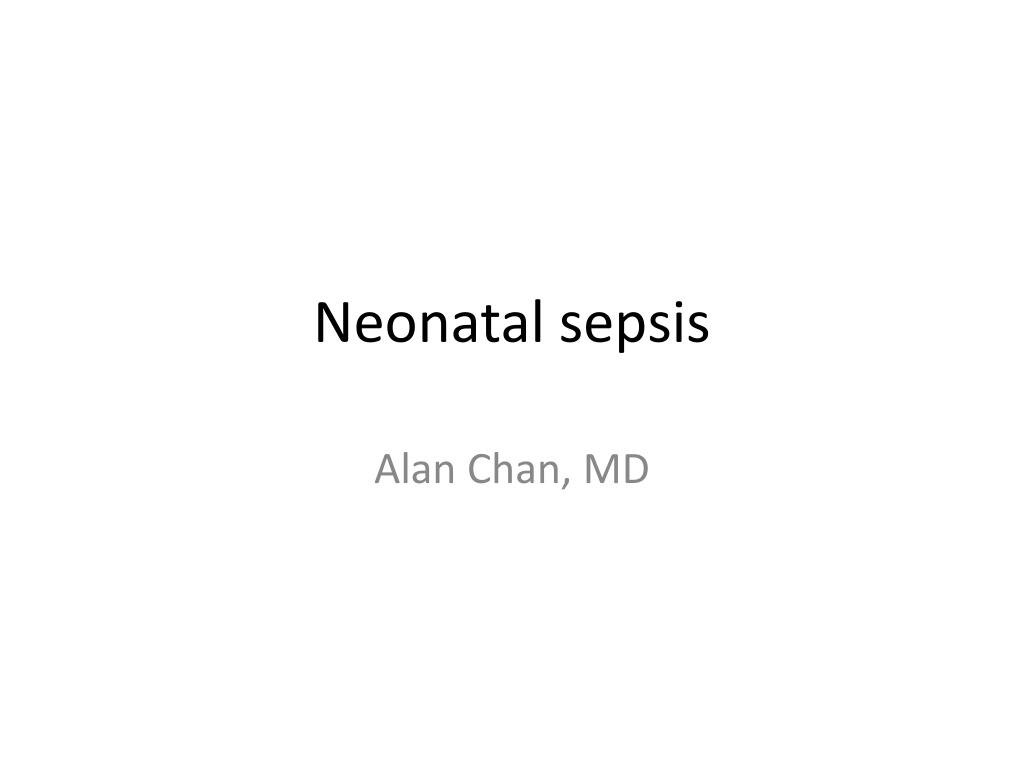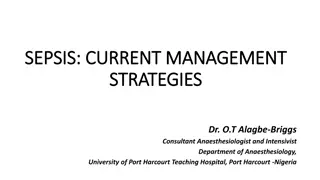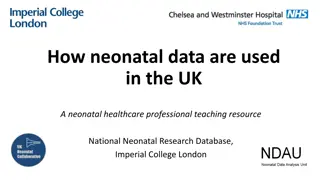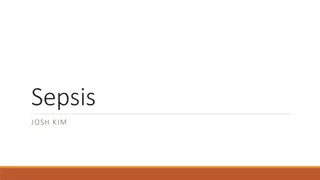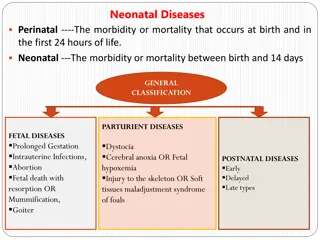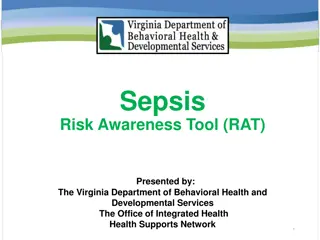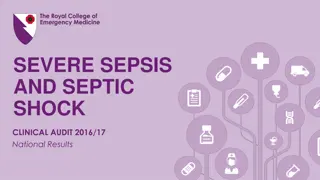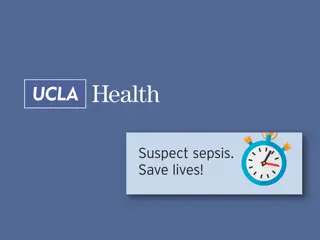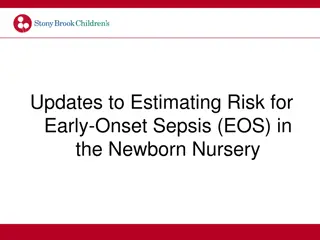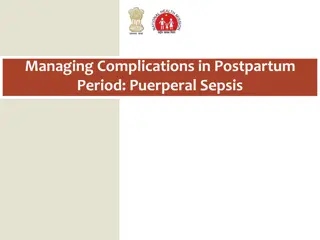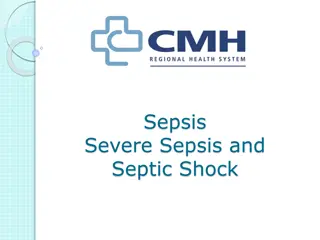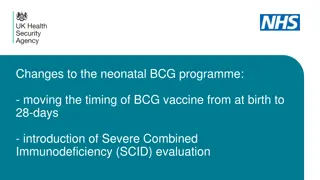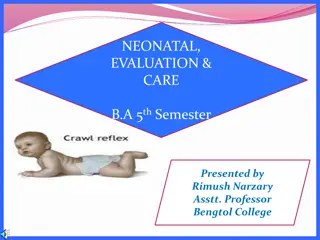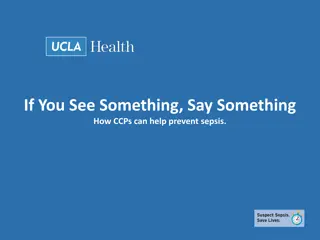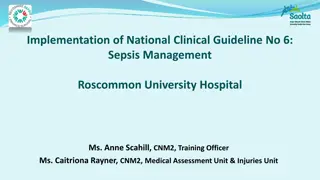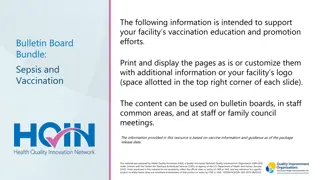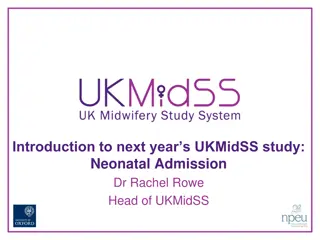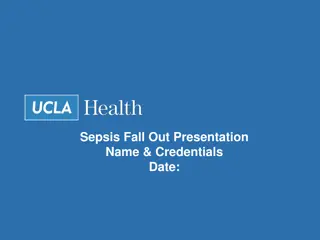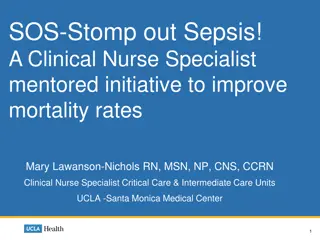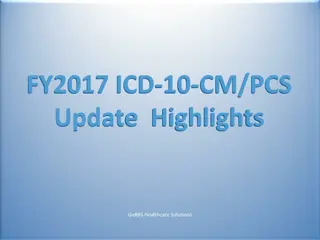Neonatal sepsis
This article by Dr. Alan Chan, MD, delves into the intricacies of neonatal sepsis, exploring its diagnosis, treatment, and impact on newborns. The author provides valuable insights and recommendations based on clinical experience and research findings. A must-read for healthcare professionals seeking comprehensive information on managing neonatal sepsis in practice.
Uploaded on Mar 02, 2025 | 0 Views
Download Presentation

Please find below an Image/Link to download the presentation.
The content on the website is provided AS IS for your information and personal use only. It may not be sold, licensed, or shared on other websites without obtaining consent from the author. Download presentation by click this link. If you encounter any issues during the download, it is possible that the publisher has removed the file from their server.
E N D
Presentation Transcript
Neonatal sepsis Alan Chan, MD
outline Definitions Signs/symptoms Evaluation Treatment Group B strep (GBS) prophylaxis Question of the day
ABP content specs Sepsis -- 1. Plan appropriate antimicrobial therapy for suspected sepsis in the immediate newborn period Streptococcus agalactiae (group B streptococcus) Understand the epidemiology of GBS Plan the appropriate management of an infant born to a mother with a positive culture for GBS Recognize the major clinical features associated with GBS, and manage appropriately Plan the appropriate management of an infant born to a mother with chorioamnionitis (CAM)
The basics Neonate < 28 days Term > 37 weeks Late preterm/near term 34-36 weeks GBS Gm pos, beta-hemolytic bacteria. Recognized in 1930s, most common cause of sepsis and meningitis < 3 months in 1970s.
Early onset sepsis (EOS) first days of life Usually from vertical transmission by contaminated amniotic fluid or from vaginal delivery in lower genital tract bloodstream infection <= 72 hr of life Early onset GBS infection with symptoms up to day 6 of life Originally defined from GBS research > 40 year ago. Consensus guidelines in 2002.
Age distribution of invasive GBS disease in infants, by age in months, weeks, or (for early- onset cases only) days. Schuchat A Clin. Microbiol. Rev. 1998;11:497-513
Late onset maternal vertical transmission leading into later infection Horizontal from providers or environment Other common organisms is E. Coli affecting mostly preterm infants.
Overall incidence of any sepsis - 1-5/1000 live births and lower in term births 1-2/1000 Incidence of EOS from GBS dropped after 2002 guidelines, but late onset increased, primarily in preterm infants. Incidence of EOS from E. coli stable, but slight increase in late onset.
Big data This data from Active Bacterial Core surveillance from CDC s Emerging Infections Program Network in 10 sites, about 42 million people. Includes Group A and B strep, H. influenzae, N. meningitidis, S. pneumoniae, and MRSA.
Other bugs Listeria rare. S. aureus skin, bone, joint Enterococcus more rare other Gm neg, eg Pseduomonas Coag neg staph (CoNS) in nosocomial infections or considered contaminant in healthy term infants
Sign/symptoms Fever Tachycardia Meconium in amniotic fluid Low APGAR @ 5 min; score <= 6 had 36x likelihood of sepsis compared to >=7. Temperature instability Jaundice, respiratory distress, hepatomegaly, anorexia/poor feeding, emesis, lethargy, cyanosis, apnea, irritability, diarrhea
Maternal factors Intrapartum temp >= 100.4 Delivery < 37 weeks (preterm!) Chorioamnionitis (CAM)- sepsis risk increases 4x) Rupture of membranes >= 18 hrs 10x risk Intrapartum antibiotic prophylaxis n.b. of moms delivering infants with EOS received abx.
Environmental risks Mostly NICU based from 2001 survey. Total parenteral nutrition (RR 3.66) Mechanical ventilation (RR 3.2) Arterial line (RR 2.43) Central venous line (RR 2.37) Peripheral catheter (RR 2.02)
Labs and stuff Blood cultures (19.80 plus sens)- get at least 0.5 ml, if not more. pos usually 24-36 hours CBC (15.59) 6-12 hrs post delivery Neutrophil count neutropenia has better specificity. A little difficult. Low with low gestational age Low in C-sections Low in arterial sample Low in low altitudes
I/T ratio (9.54) 90th percentile in healthy infants is 0.27; has a high Negative predictive value (if the test is negative, then the kid really does not have the disease) CRP (9.78) acute phase reactant triggered by cytokines (TNF-alpha, IL-6) - good for following disease. If < 1 after 24-48hr on abx, then probably safe. Procalcitonin (45.44) release by parenchymal cells in response to bacterial toxins. Potentially better than CRP.
Lumbar puncture (23.73 plus culture) AAP says do if pos blood culture, looks like sepsis either clinically or from labs, gets worse on abx. Urine culture (7.28) in >=6 days (if urine is pos in younger, then it s really bacteremia) CXR (23.71 + 0.66 RVUs) Other inflammatory markers amyloid A, IL- 1Beta, E-selectin??
Treatment Amp and gent!!! - ampicillin 150-300 mg/kg/day per chronologic age (APH algorithm 200 div q8h and dose can be dropped if meningitis ruled out), gentamicin 4mg/kg/day) Cefotax and gent Vanc and nafcillin and gent GBS known? use PCN G Follow the antimicrobial susceptibility chart
Supportive care Oxygenation Perfusion Thermoneutral environment Continue abx for 10-14 days for blood stream, 2-3 weeks for meningitis
Morbidity preterm infants most affected Sepsis increased risk in newborns with patent ductus arteriosus, bronchopulmonary dysplasia, necrotizing entercolitis, and duration of hospital stay. Cognitive development although study was in mostly ELBW/VLBW infants.
Debate in 2012 Committee for Fetus and Newborn women with suspected CAM, continue abx in neonate if BCx neg and if labs abnormal. Then they said discontinue if sepsis risk is low . Then they said do not treat term neonate, whose mom was treated for CAM, with neg BCx beyond 48-72 hrs, even when infant s blood work is abnormal. Original CDC guidelines in 2002 resulted in 12- 15% evaluations
Effect of this??? Lowered costs without effecting short term harms (other EOS evaluations, total NICU admits, frequency infants were evaluated for other symptoms prior to discharge, or incidence of EOS)! Less infants requiring EOS evaluations in term and late preterm CDC with 2010 updates dropping 25% of those evaluations.
Polin RA, Watterberg K, Benitz W, et al. The Conundrum of Early-Onset Sepsis. Pediatrics. 2014; 133; 1122.
Intrapartum Antibiotic Prophylaxis (IAP) Screen in 35-37 wk of gestation swab vagina/rectum Give if positive screen, hx of infant with invasive GBS, or GBS bacteruria. If latter early in pregnancy, treat, then document sterile urine and assume colonization. OR if culture unknown at < 37 wks of gestation, ROM >= 18 hrs, temp > 100.4, OR positive PCR. Give PCN/amox/keflex; clindamycin if allergy. If clindamycin allergy or resistant, desensitize mom to PCN.
workup of infant Sepsis see prior slides CAM? see last slide Did mom get need GBS ppx? No RNBC Yes, got abx, then watch infant NO, was term AND ROM < 18 hrs? Yes, watch and maybe get cbc NO, either was preterm OR ROM >=18 hrs, get more blood work (cbc, culture), watch Can swing to sepsis workup anytime RNBC- routine newborn care.
Question of the day? Called for C-section of 42 wk b/c Failure to progress with severe oligohydramnios. Maternal screens neg, incld GBS. ROM at delivery shows scant fluid with meconium stain. Exam vigorous and good RR, HR > 100, central cyanosis, meconium stain with pelling post dates skin. Give BBO2 improving color, but then tachypnea and grunting at 5 min. Go to specials, tubed, and CVL placed. Pre and post ductal sats at 97% on 60 % FiO2.
Diffuse patchy, pleural effusion, hyperinflation What does this look like? GBS pna mec asp syndrome Persistent pulm HTN Retained fetal lung liquid syndrome Transposition of great vessels
references Schuchat A. Epidemiology of Group B Streptococcal Disease in the United States: Shifting Paradigms. Clin Micro Rev. 1998. 11: 3; 497-513 Hornik CP, Benjamin DK, Becker KC, et al. Use of the complete blood cell count in early-onset neonatal sepsis. Pediatr Infect Dis J 2012; 31:799. Stoll BJ, Hansen NI, Adams-Chapman I, et al. Neurodevelopmental and growth impairment among extremely low- birth-weight infants with neonatal infection. JAMA 2004; 292:2357. Stoll BJ, Hansen N, Fanaroff AA, et al. Late-onset sepsis in very low birth weight neonates: the experience of the NICHD Neonatal Research Network. Pediatrics 2002; 110:285. Polin RA, Watterberg K, Benitz W, et al. The Conundrum of Early-Onset Sepsis. Pediatrics .2014 ; 133; 1122 Kiser C, Nawab U, McKenna K, et al. Role of Guidelines on Length of Therapy in Chorioamnionitis and Neonatal Sepsis. Pediatrics 2014. 133;992. Edwards MS. Clinical features and diagnosis of sepsis in term and late preterm infants. Uptodate.com. Accessed on 8/1/2014 Edwards MS. Treatment and outcome of sepsis in term and late preterm infants. Uptodate.com. Accessed on 8/1/2014. Weisman LE, Pammi M. Clinical features and diagnosis of bacterial sepsis in the preterm infant. Uptodate.com. Accessed on 8/1/2014. Weisman, LE, Pammi M. Treatment and prevention of bacterial sepsis in the preterm infant. Uptodate.com. Accessed on 8/1/2014. Mukhopadhyay S, Dukhovny D, Mao W, et al. 2010 Perinatal GBS Prevention Guideline and Resource Utilization. Pediatrics 2014. 133;196. Yuan H, Huang J, Lv B, et al. Diagnosis Value of the Serum Amyloid A Test in Neonatal Sepsis: A Meta-Analysis. BioMed Res Internat 2013. Article ID 520294. PREP questions.
